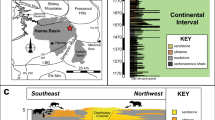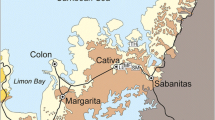Abstract
The Middle Triassic protorosaur Tanystropheus has been considered as both a terrestrial and aquatic taxon based on several lines of biomechanical and distributional evidence, but determining conclusively which habitat was most likely has remained problematic. Specimens of Tanystropheus longobardicus from the Middle Triassic Besano Formation, Monte San Giorgio, are used to investigate the possibility that palaeoecology can be inferred from skeletal taphonomy, which is compared to that of the pachypleurosaurid Serpianosaurus mirigiolensis (considered to be entirely aquatic) and the protorosaur Macrocnemus bassanii (terrestrial) from the same formation. The preservation of Tanystropheus was found to be more similar to Macrocnemus than Serpianosaurus implying carcasses of Tanystropheus originated in terrestrial or at least marginal and near-shore, shallow marine settings. That these were also the most probable habitats in life is supported by the relatively lower number of Tanystropheus (and also Macrocnemus) compared to Serpianosaurus. The study has further implications for the integument of the taxon, which remained sufficiently coherent to prevent the loss of disarticulated elements during an interval of floating necessary to reach the Monte San Giorgio Basin where carcasses came to finally rest. Loss of skeletal completeness was subsequent to arrival at the seabed and as a result of weak bottom current activity that also affected Serpianosaurus.









Similar content being viewed by others
References
Bassani, F. (1886). Sui fossili e sull’età degli schisti bituminosi triassici di Besano in Lombardia. Atti Società Italiana di scienze naturali, 29, 15–72.
Beardmore, S. R. (2012). The skeletal taphonomy of vertebrates from the Triassic and Jurassic. Unpublished Ph.D, University College Dublin, Ireland, pp 272.
Beardmore, S. R., Orr, P. J., Manzocchi, T., Furrer, H., & Johnson, C. (2012). Death, decay and disarticulation: a method of modelling the skeletal taphonomy of marine reptiles demonstrated using Serpianosaurus (Reptilia; Sauropterygia). Palaeogeography, Palaeoclimatololgy, Palaeoecology, 337, 1–13.
Bernasconi, S. M. (1991). Geochemical and microbial controls on dolomite formation and organic matter production/preservation in anoxic environments: a case study from the Middle Triassic Grenzbitumenzone, Southern Alps (Ticino, Switzerland). PhD Thesis, Geological Institute of the ETH, Zürich, Switzerland.
Bernasconi, S. M. (1994). Geochemical and microbial controls on dolomite formation in anoxic environments. A case study from the middle Triassic (Ticino, Switzerland). Contributions to sedimentology, 19, 1–109.
Brack, P., & Rieber, H. (1993). Towards a better definition of the Anisian/Ladinian boundary: new biostratigraphic data and correlations of boundary sections from the Southern Alps. Eclogae Geologicae Helvetiae, 86, 415–527.
Brack, P., Rieber, H., Nicora, A., & Mundil, R. (2005). The global boundary stratotype section and point (GSSP) of the Ladinian Stage (Middle Triassic) at Bagolino (Southern Alps, Northern Italy) and its implications for the Triassic time scale. Episodes, 28, 233–244.
Brand, L. R., Hussey, M., & Taylor, J. (2003). Decay and disarticulation of small vertebrates in controlled experiments. Journal of Taphonomy, 1, 69–95.
Brinkmann, W. (1994). (Hrsg., mit Beiträgen). In T. von Bolliger, W. Brinkmann, H. Furrer, K. A. Hünermann, H. Lanz, & H. Rieber (Eds.), Paläontologisches Museum der Universität Zürich. Führer durch die Ausstellung (p. 108 S). Zürich: Verlag Paläontologisches Institut und Museum Universität.
Brinkmann, W., & De Baets, K. (2012). Paleontological Museum of the University of Zürich. Exhibition guide (p. 108). Zürich: Paleontological Institute and Museum of the University.
Bürgin, T., Rieppel, O., Sander, P. M., & Tschanz, K. (1989). The fossils of Monte San Giorgio. Scientific American, 260, 50–57.
Cox, B. (1975). The longest-necked lizard? Nature, 254, 654–655.
Dalla Vecchia, F. B. (2000). Tanystropheus (Archosauromorpha, Prolacertiformae) remains from the Triassic of Northern Friuli (NE Italy). Rivista Italiana di Paleontologia e Stratigrafia, 106, 135–140.
Diedrich, C. (2008). Millions of reptile tracks—Early to Middle Triassic carbonate tidal flat migration bridges of Central Europe—reptile immigration into the Germanic Basin. Palaeogeography, Palaeoclimatology, Palaeoecology, 259, 410–423.
Efremov, J. A. (1940). Taphonomy: a new branch of paleontology. Pan-American Geologist, 74, 81–93.
Fraser, N. C., & Rieppel, O. (2006). A new protorosaur (Diapsida) from the Upper Bundsandstein of the Black Forest, Germany. Journal of Vertebrate Paleontology, 26, 866–871.
Furrer, H. (1995). The Kalkschieferzone (Upper Meride Limestone; Ladinian) near Meride (Canton Ticino, Southern Switzerland) and the evolution of a Middle Triassic intraplatform basin. Eclogae Geologicae Helvetiae, 88, 827–852.
Furrer, H. (2003). Der Monte San Giorgio im Südtessin—vom Berg der Saurier zur Fossil-Lagerstätte internationaler Bedeutung. Neujahrsblatt der Naturforschenden Gesellschaft Zürich, 206, 64.
Furrer, H., & Vandelli, A. (2014). Guide to the museum of fossils from Monte San Giorgio Meride. Fondazione del Monte San Giorgio, Meride, pp 128. ISBN 978-88-940067-2-8.
Hammer, Ø., Harper, D. A. T., & Ryan, P. D. (2001). PAST: Paleontological Statistics Software Package for Education and Data Analysis. Palaeontologia Electronica, 4(1), 9. http://palaeo-electronica.org/2001_1/past/issue1_01.htm.
Haubold, H. A. (1983). Archosaur evidence in the Buntsandstein (Lower Triassic). Acta Palaeontologica Polonica, 28, 123–132.
Hugi, J., Scheyer, T. M., Sander, P. M., Klein, N., & Sánchez-Villagra, M. R. (2011). Long bone microstructure gives new insights into the life of pachypleurosaurids from the Middle Triassic of Monte San Giorgio, Switzerland/Italy. Comptes Rendus Palevol, 10(5), 413–426.
Krebs, B. (1965). Die Triasfauna der Tessiner Kalkalpen, XIX. Ticinosuchus ferox nov. gen. nov. sp. Schweizerische Paläontologische Abhandlungen, 81, 1–140.
Kuhn-Schnyder, E. (1974). Die Triasfauna der Tessiner Kalkalpen. Neujahrsblatt der Naturforschenden Gesellschaft Zürich, 176, 1–119.
Li, C., Rieppel, O., & LaBarbera, M. C. (2004). A Triassic aquatic protorosaur with an extremely long neck. Science, 305, 1111–1113.
Melville, R. V., & Freshney, E. C. (1982). British regional geology: the Hampshire Basin and adjoining areas (Fourth ed.). London: Her Majesty’s Stationary Office.
Meyer, H. V. (1847-1855). Zur Fauna der Vorvelt. Zweite Abteilung Die Saurier des Muschelkalks mit Rücksicht auf die Saurier aus Buntem Sandstein und Keuper (p. 167). Frankfurt am Main: Keller.
Mundil, R., Palfy, J., Renne, P. R., & Brack, P. (2010). The Triassic timescale: New constraints and a review of geochronological data. Geological Society of London, Special Publications, 334, 41–60.
Nosotti, S. (2007). Tanystropheus longobardicus Reptilia, Protorosauria: reinterpretation of the anatomy based on new specimens from the Middle Triassic of Besano (Lombardy, northern Italy). Memorie della Società Italiana di Scienze Naturali e del Museo Civico di Storia Naurale di Milano, 35(3), 88.
Peyer, B. (1931). Die Triasfauna der Tessiner Kalkalpen. II. Tanystropheus longobardicus BASS sp. Abhandlungen der Schweizerischen Paläontologischen Gesellschaft, 50, 5–110.
Reisdorf, A. G., & Wuttke, M. (2012). Re-evaluating Moodie’s opisthotonic-posture hypothesis in fossil vertebrates part I: reptiles—the taphonomy of the bipedal dinosaurs Compsognathus longipes and Juravenator starki from the Solnhofen Archipelago (Jurassic, Germany). Palaeobiodiversity and Palaeoenvironments, 92, 119–168.
Reisdorf, A. G., Bux, R., Wyler, D., Benecke, M., Klug, C., Maisch, M. W., Fonaro, P., & Wetzel, A. (2012). Float, explode or sink: post-mortem fate of lung-breathing marine vertebrates. Palaeobiodiversity and Palaeoenvironments, 92, 67–81.
Renesto, S. (2005). A new specimen of Tanystropheus (Reptilia Protorosauria) from the Middle Triassic of Switzerland and the ecology of the genus. Rivista Italiana di Paleontologia e Stratigrafia, 11, 377–394.
Renesto, S. (2006). Peculiar preservation of a juvenile pachypleurosaurid from Besano, Italy. Rivista Italiana di Paleontologia e Stratigrafia, 112, 373–382.
Renesto, S., & Dalla Vecchia, F. M. (2000). The unusual dentition and feeding habits of the prolacertiform reptile Langobardisaurus (Late Triassic, Northern Italy). Journal of Vertebrate Paleontology, 20(3), 622–627.
Rieppel, O. (1989a). The hind limb of Macrocnemus bassanii (Nopsca) (Reptilia, Sauropterygia): development and functional anatomy. Journal of Vertebrate Paleontology, 9, 373–387.
Rieppel, O. (1989b). A new pachypleurosaurid (Reptilia, Sauropterygia) from the Middle Triassic of Monte San Giorgio, Switzerland. Philosophical Transactions of the Royal Society of London B, 323, 1–73.
Rieppel, O. (2010). Tanystropheus cf. T. longobardicus from the early Late Triassic of Guizhou Province, southwestern China. Journal of Vertebrate Paleontology, 30, 1082–1089.
Röhl, H. J., Schmid-Röhl, A., Furrer, H., Frimmel, A., Oschmann, W., & Schwark, L. (2001). Microfacies, geochemistry and palaeoecology of the Middle Triassic Grenzbitumenzone from the Monte San Giorgio (Canton Ticino, Switzerland). Geologia Insubrica, 6, 1–13.
Sander, P. M. (1989). The pachypleurosaurids (Reptilia: Nothosauria) from the Middle Triassic of Monte San Giorgio (Switzerland) with the description of a new species. Philosophical Transactions of the Royal Society of London B: Biological Sciences, 325(1230), 561–666.
Schäfer, W. (1972) (translated version). Ecology and palaeoecology in marine environments (pp. 1–568). Chicago: The University of Chicago Press.
Stockar, R., Baumgartner, P. O., & Condon, D. (2012). Integrated Ladinian bio-chronostratigraphy and geochrononology of Monte San Giorgio (Southern Alps, Switzerland). Swiss Journal of Geosciences, 105, 85–108.
Tschanz, K. (1988). Allometry and heterochrony in the growth of the neck of Triassic prolacertiform reptiles. Palaeontology, 31, 997–1011.
Wild, R. (1973). Die Triasfauna der Tessiner Kalkalpen XXIII Tanystropheus longobardicus (Bassani). Schweizerische Paläontologische Abhandlungen, 95, 1–162.
Wild, R. (1980). Die Triasfauna der Tessiner Kalkalpen. XXIV. Neue Funde von Tanystropheus (Reptilia, Squamata). Schweizerische Paläontologische Abhandlungen, 102, 1–43.
Acknowledgements
We thank Patrick Orr for helpful discussion throughout this study. We also thank Silvio Renesto and Nick Fraser for their comments and improvements to the manuscript. Research was conducted as part of a Ph.D project at University College Dublin, funded by the Irish Research Council for Science, Engineering and Technology (IRCSET).
Author information
Authors and Affiliations
Corresponding author
Ethics declarations
Conflict of interest
The authors declare that they have no conflict of interest.
Rights and permissions
About this article
Cite this article
Beardmore, S.R., Furrer, H. Land or water: using taphonomic models to determine the lifestyle of the Triassic protorosaur Tanystropheus (Diapsida, Archosauromorpha). Palaeobio Palaeoenv 98, 243–258 (2018). https://doi.org/10.1007/s12549-017-0299-7
Received:
Revised:
Accepted:
Published:
Issue Date:
DOI: https://doi.org/10.1007/s12549-017-0299-7




